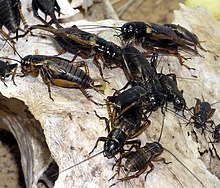Gryllus bimaculatus
| Gryllus bimaculatus | |
|---|---|
 |
|
| Scientific classification | |
| Kingdom: | Animalia |
| Phylum: | Arthropoda |
| Class: | Insecta |
| Order: | Orthoptera |
| Suborder: | Ensifera |
| Family: | Gryllidae |
| Genus: | Gryllus |
| Species: | G. bimaculatus |
| Binomial name | |
|
Gryllus bimaculatus De Geer, 1773 |
|
Gryllus bimaculatus is one of many cricket species known as field crickets. Also known as the African or Mediterranean field cricket or as the two-spotted cricket, it can be discriminated from other Gryllus species by the two dot-like marks on the base of its wings.
The species is popular for use as a food source for insectivorous animals like spiders and reptiles kept as pets or in zoos. They are easy to raise and do not require prolonged exposure to cold in order to complete their life cycle.
In the wild, male crickets do not tolerate one another and will fight until there is a winner. The loser usually retreats without serious injury. The fighting method involves opening the mandibles as wide as possible, gripping the opponent's mandibles and pushing with the hind legs.
Male crickets of this species produce several distinctive chirps, though each sound is made by rubbing the two outer wings together. Loud and steady chirps made throughout the night are to attract females and to warn off other males. Loud fast-frequency chirps are emitted when males encounter one another and are preparing to fight. They are intended to frighten off the rival male. A soft clipping sound is made when a female is known to be nearby. Its purpose is to encourage the female to mate.
These crickets can be found hiding under logs, grasses, and in crevices. They can also dig holes into the ground to create homes for themselves, or live in holes created by other animals. Males are territorial and will fight off other males, but allow any number of females to coexist in the same shelter.
Cannibalism is extremely rare, but females have been observed to eat males if there is not enough food to eat.
Pigment Dispersing Factor has been implicated in the nocturnal rhythms of crickets.
Females have a tubular organ at the rear, known as an ovipositor, which is used to lay eggs into the ground. They lay their eggs into humid soil and the baby crickets hatch in about two weeks.
Gryllus bimaculatus exhibit polygamy, in which one individual has many different mates. Variation of polygamous behavior occurs between males and females, within a population of Gryllus bimaculatus. Both females and males continuously seek mates with whom they can spread their seed. Polyandry is the most common form of polygamy practiced in G. bimaculatus. This means that female crickets will mate with more than one male. Male crickets do not exhibit polygyny.
...
Wikipedia
